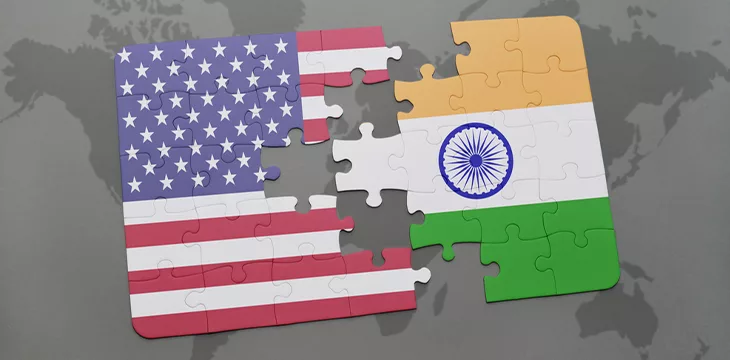
|
Getting your Trinity Audio player ready... |
India and the United States intend to expand collaboration across key technology sectors, including semiconductors, advanced telecommunications, artificial intelligence (AI), quantum, biotechnology, and clean energy.
“India is committed to further strengthen the India-US comprehensive global strategic partnership for global good,” India’s Prime Minister Narendra Modi wrote on X after his meeting with U.S. National Security Advisor Jake Sullivan.
Sullivan was in India for the second meeting of the U.S.-India Initiative on Critical and Emerging Technology (CET)—an initiative introduced in January 2023. Sullivan also met his Indian counterpart Ajit Doval. The two National Security Advisors met to set the vision for the next chapter of the technology partnership, the two countries said in a joint fact sheet.
The aim is to ensure that the U.S. and India stay at the leading edge of innovation and improve coordination with like-minded nations to deliver secure, reliable, and cost-competitive technology solutions. Sullivan and Doval underscored the vital importance of adapting “technology protection toolkits” and resolved to prevent the “leakage” of sensitive and dual-use technologies to “countries of concern,” the fact sheet stated.
The meetings come at a time when the world’s biggest and second-biggest economies are in a trade war, which started in January 2018, when former U.S. President Donald Trump began setting tariffs and other trade barriers on China. In May 2024, U.S. President Joe Biden directed his trade representative to increase tariffs on $18 billion of imports from China to protect American workers and businesses, the White House said in a statement.
“President Biden’s economic plan is supporting investments and creating good jobs in key sectors that are vital for America’s economic future and national security. China’s unfair trade practices concerning technology transfer, intellectual property, and innovation are threatening American businesses and workers,” the White House said.
Simultaneously, the Narendra Modi-led Indian government has been reportedly positioning India as an alternative for global tech companies looking to reduce dependence on China for their supply chains. The fastest-growing major economy has already lured suppliers for major U.S. corporations like Apple (NASDAQ: AAPL) and Google (NASDAQ: GOOGL). Google has reportedly asked local suppliers to begin production of its Pixel smartphones in India. At the same time, about 25% of all iPhones are expected to be made in India by 2028, from only 5% to 7% of Apple’s manufacturing in January 2023.
The road ahead
The joint fact sheet stated that the U.S. and India would focus on unlocking a combined $90 million in U.S. and Indian government funding over the next five years for the U.S.-India Global Challenges Institute, which will forge high-impact university and research partnerships between U.S. and Indian institutions in the areas of semiconductor technology and manufacturing, critical and emerging technologies, among other issues.
The two countries also plan to announce the selection of the first tranche of funding awards between the National Science Foundation and the Indian Department of Science and Technology, totaling nearly $5 million, to support the joint U.S.-India research projects in areas such as next-generation telecommunications, connected and autonomous vehicles, and machine learning.
The U.S. and India will focus on securing a carrier for the first-ever joint effort between NASA and ISRO astronauts at the International Space Station, which will mark a significant milestone in the U.S.-India space partnership and space exploration.
The two countries plan to launch a new partnership between the U.S. Space Force and the Indian startups 114ai and 3rdiTech. The countries intend to advance space situational awareness, data fusion technologies, and infra-red sensor semiconductor manufacturing.
India and the U.S. will build partnerships to deploy high-quality, cost-effective Open RAN technology at scale, including a $5 million USAID Edge Fund grant to Qualcomm and Mavenir to test its ORAN stack in India in partnership with telecom service provider Bharti Airtel, with Qualcomm contributing an additional $9.4 million to the project. Open Radio Access Networks, or ORAN, is a more cost-effective, secure, and energy-efficient approach to building mobile networks needed to connect smartphones and devices to the internet and other users.
Both countries also look forward to introducing a new semiconductor partnership between General Atomics and 3rdiTech to co-develop semiconductor design and manufacturing for precision-guided ammunition and other national security-focused electronics platforms.
The U.S. and India will pursue quantum, artificial intelligence, and high-performance computing collaboration, the joint fact sheet added. They plan on initiating new cooperation in quantum science and technology, including a workshop on post-quantum cryptography at the University of California, Los Angeles, and facilitate visits of Indian technical experts to U.S. national laboratories and quantum institutions.
Watch: Exploring use cases for blockchain in India
Recommended for you
Lorem ipsum odor amet, consectetuer adipiscing elit. Elit torquent maximus natoque viverra cursus maximus felis. Auctor commodo aliquet himenaeos fermentum
Lorem ipsum odor amet, consectetuer adipiscing elit. Accumsan mi at at semper libero pretium justo. Dictum parturient conubia turpis interdum

 11-21-2024
11-21-2024


